Broadcom BRCM1052 802.11 agn WLAN + BT PCI-E Minicard User Manual User Guide
Broadcom Corporation 802.11 agn WLAN + BT PCI-E Minicard User Guide
Broadcom >
Contents
User Guide
Congratulations, you and your MacBook Air
were made for each other.
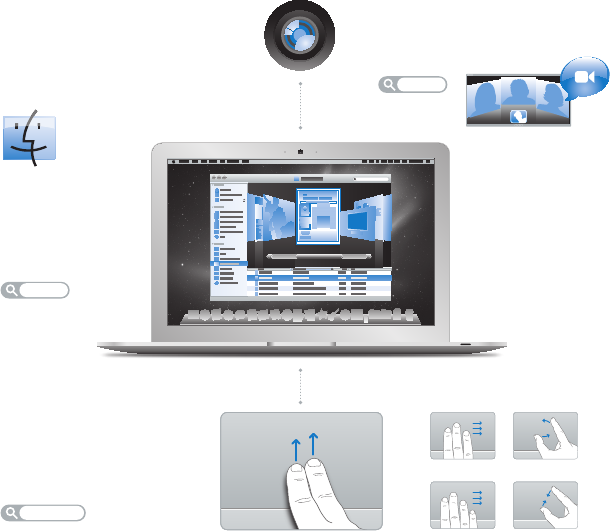
Say hello to your MacBook Air.
www.apple.com/macbookair
Four fingers
swipe Pinch and
expand
Swipe Rotate
MacBook Air
Built-in iSight camera and iChat
Video chat with friends and
family anywhere in the world.
Mac Help
isight
finder
Finder
Browse your files
like you browse
your music with
Cover Flow.
Mac Help
trackpad
Multi-Touch trackpad
Scroll through files, adjust
images, and enlarge text
using just your fingers.
Mac Help
Scroll
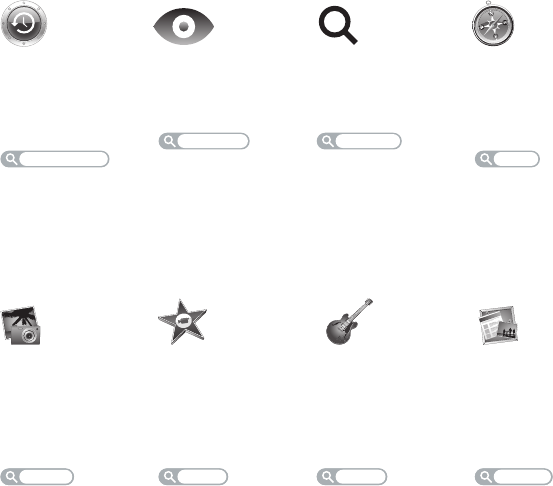
iLife
www.apple.com/ilife
Time Machine
Automatically
back up and
restore your files.
Mac Help
Spotlight
Find anything
on your Mac.
Mac Help
time machine
spotlight
Safari
Experience the web
with the fastest
browser in the world.
Mac Help
safari
Quick Look
Instantly preview
your files.
Mac Help
quick look
iPhoto
Organize and
search your
photos by faces,
places, or events.
iPhoto Help
photos
iMovie
Make a great-
looking movie in
minutes or edit
your masterpiece.
iMovie Help
movie
GarageBand
Learn to play.
Start a jam session.
Record and mix
your own song.
GarageBand Help
record
iWeb
Create custom
websites and publish
them anywhere with
a click.
iWeb Help
website
iPhoto
Organize and
search your
photos by faces,
places, or events.
iPhoto Help
photos
iMovie
Make a great-
looking movie in
minutes or edit
your masterpiece.
iMovie Help
movie
GarageBand
Learn to play.
Start a jam session.
Record and mix
your own song.
GarageBand Help
record
iWeb
Create custom
websites and publish
them anywhere with
a click.
iWeb Help
website
Mac OS X Snow Leopard
www.apple.com/macosx
5Contents
Contents
Chapter 1: Ready, Set Up, Go
8 Welcome
9 What’s in the Box
10 Setting Up Your MacBook Air
15 Setting Up DVD or CD Sharing
16 Migrating Information to Your MacBook Air
19 Getting Additional Information onto Your MacBook Air
22 Putting Your MacBook Air to Sleep or Shutting It Down
Chapter 2: Life with Your MacBook Air
26 Basic Features of Your MacBook Air
28 Keyboard Features of Your MacBook Air
30 Ports on Your MacBook Air
32 Using the Trackpad and Keyboard
35 Running Your MacBook Air on Battery Power
36 Getting Answers
Chapter 3: Problem, Meet Solution
40 Problems That Prevent You from Using Your MacBook Air
43 Using Apple Hardware Test
6Contents
44 Reinstalling Software Using Remote Install Mac OS X
49 Reinstalling Software Using the MacBook Air SuperDrive
50 Problems with AirPort Extreme Wireless Communication
50 Problems with Your Internet Connection
52 Keeping Your Software Up to Date
52 Learning More, Service, and Support
55 Locating Your Product Serial Number
Chapter 4: Last, but Not Least
58 Important Safety Information
61 Important Handling Information
62 Understanding Ergonomics
64 Apple and the Environment
65 Regulatory Compliance Information
Looking for Something?
70 Index
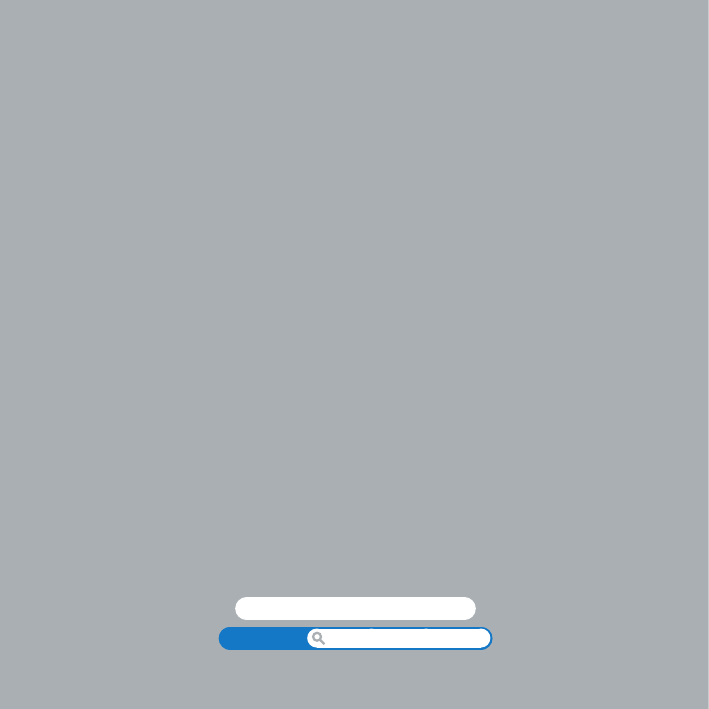
Mac Help Migration Assistant
www.apple.com/macosx
Mac Help Migration Assistant
www.apple.com/macbookair
Ready, Set Up, Go
1
8Chapter 1 Ready, Set Up, Go
Welcome
Congratulations on purchasing a MacBook Air. Your MacBook Air is streamlined for
portability and a completely wireless experience. Read this chapter for help getting
started setting up and using your MacBook Air.
ÂIf you know you won’t be migrating information from another Mac, and you’d like to
get started using your MacBook Air right away, you can follow the Setup Assistant to
set up your MacBook Air quickly.
ÂIf you want to migrate information from another Mac or get content from DVDs or
CDs onto your MacBook Air you can set up one or more Mac or Windows computers
to partner with your MacBook Air. Then follow the Setup Assistant and use DVD or
CD Sharing to use your MacBook Air to get the information from the other computer.
Important: Read all the installation instructions (and the safety information starting on
page52)carefullybeforeyourstuseyourcomputer.
Many answers to questions can be found on your computer in Mac Help. For
information about getting Mac Help, see “Getting Answers” on page 35. Apple may
release new versions and updates to its system software, so the images shown in
thisbookmaybeslightlydierentfromwhatyouseeonscreen.
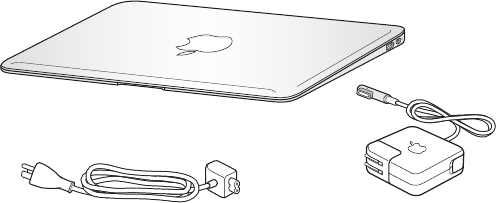
9Chapter 1 Ready, Set Up, Go
What’s in the Box
AC power cord
AC
plug
45W MagSafe Power Adapter
Important: Removetheprotectivelmcoveringthe45WMagSafePowerAdapter
before setting up your MacBook Air.
Setting Up Your MacBook Air
Your MacBook Air is designed so that you can set it up quickly and start using it right
away. The following pages take you through the setup process, including these tasks:
ÂPlugginginthe45WMagSafePowerAdapter
ÂTurning on your MacBook Air
ÂUsingSetupAssistanttoaccessanetworkandcongureauseraccountandother
settings
ÂSetting up the Mac OS X desktop and preferences
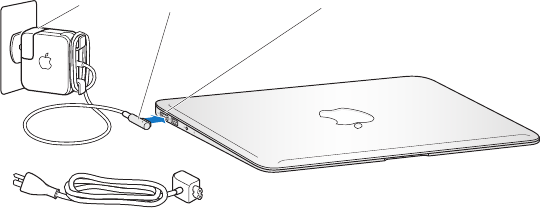
10 Chapter 1 Ready, Set Up, Go
Step 1: Plug in the 45W MagSafe Power Adapter to provide power to the
MacBook Air and charge the battery.
Make sure the AC plug is fully inserted into the power adapter and the electrical
prongs on your AC plug are in their completely extended position. Insert the AC
plug of your power adapter into a power outlet and the MagSafe connector into the
MagSafe power port. As the MagSafe connector gets close to the port, you’ll feel a
magnetic pull drawing it in.
¯
AC power cord
AC plug MagSafe power port
MagSafe connector
To extend the reach of your power adapter, replace the AC plug with the AC power
cord. First pull the AC plug up to remove it from the adapter, and then attach the
included AC power cordtotheadapter,makingsureitisseatedrmly.Plugtheother
end into a power outlet.
When disconnecting the power adapter from an outlet or from the computer, pull the
plug, not the cord.
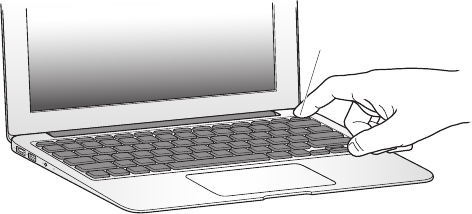
11Chapter 1 Ready, Set Up, Go
When you connect the power adapter to your MacBook Air, an indicator light on
the MagSafe connector starts to glow. An amber light indicates that the battery is
charging. A green light indicates that the battery is fully charged. If you don’t see a
light, make sure the connector is seated properly and the power adapter is plugged
into a working power outlet.
Step 2: Press the power (®) button briey to turn on your MacBook Air.
The power button is located in the upper right corner of your keyboard. When you turn
on the computer, you’ll hear a tone.
® Power button
It takes the computer a few moments to start up. After it starts up, Setup Assistant
opens automatically.
If your computer doesn’t turn on, see “If your MacBook Air doesn’t turn on or start up”
onpage42.
12 Chapter 1 Ready, Set Up, Go
Step 3: Congure your MacBook Air with Setup Assistant.
ThersttimeyouturnonyourMacBookAir,SetupAssistantstarts.SetupAssistant
helps you enter your Internet information and set up a user account on your
MacBook Air. You can also migrate information from another Mac during setup.
Note: Ifyoudon’tuseSetupAssistanttotransferinformationwhenyourststartup
your MacBook Air, you can do it later using Migration Assistant. Go to the Applications
folder, open Utilities, and double-click Migration Assistant.
To set up your MacBook Air:
1 In the Setup Assistant, follow the onscreen instructions until you get to the “Do You
Already Own a Mac?” screen.
2 Do a basic setup or a setup with migration:
ÂTo do a basic setup, select “Do not transfer my information now” and click Continue.
Follow the remaining prompts to select your wireless network, set up an account, and
exit Setup Assistant.
ÂTo do a setup with migration, select the Mac you want to migrate information from.
You may have to update software if the other Mac doesn’t have Mac OS X
version 10.5.3 or later installed. Then go to page 15, “Migrating Information to Your
MacBook Air.”
Note: After you start Setup Assistant on your MacBook Air, you can leave it midprocess
without quitting, move to the other computer if you need to update its software, and
then return to your MacBook Air to complete the setup.
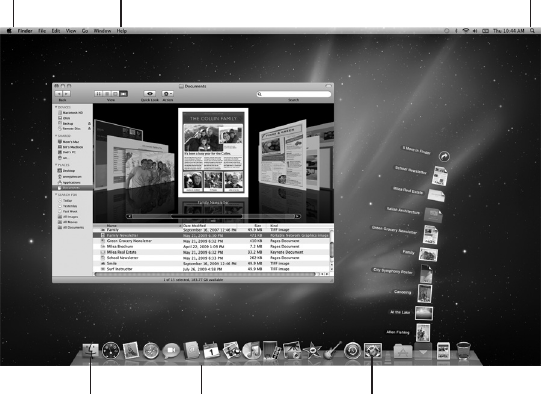
13Chapter 1 Ready, Set Up, Go
Step 4: Customize the Mac OS X desktop and set preferences.
You can quickly make the desktop look the way you want using System Preferences.
ChooseApple()>SystemPreferencesfromthemenubarorclicktheSystem
Preferences icon in the Dock. System Preferences is your command center for most
settings on your MacBook Air.
Menu bar Help menu Spotlight search icon
Finder icon System Preferences iconDock
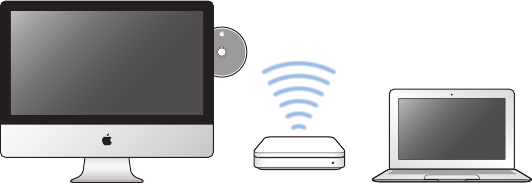
14 Chapter 1 Ready, Set Up, Go
Setting Up DVD or CD Sharing
You can partner your MacBook Air with another Mac or Windows computer that has
an optical disc drive and is on the same wired or wireless network. Use this other
computer to:
ÂMigrate information to your MacBook Air, if the other computer is a Mac (see
“Migrating Information to Your MacBook Air” on page 15)
ÂShare the contents of DVDs or CDs or install applications (see “Sharing Discs with
DVD or CD Sharing” on page 18)
ThecomputerwiththeopticaldrivecanbeaMacwithMacOSXv10.4.11orlater,ora
Windows XP or Windows Vista computer. If the Mac has Mac OS X v10.5.3 or later, DVD
or CD Sharing is already installed. You can partner with more than one other computer,
but you can use only one partner computer at a time.
Mac or Windows computer MacBook Air
15Chapter 1 Ready, Set Up, Go
If the other computer is a Windows computer or a Mac with a Mac OS X version
earlier than 10.5.3, download the DVD or CD Sharing Setup software for your partner
computer:
ÂIf the other computer is a Windows computer, go to: http://support.apple.com/
downloads/DVD_or_CD_Sharing_Update_1_0_for_Windows
ÂIftheothercomputerisaMacwithMacOSXv10.4.10-10.5.2,goto:
http://support.apple.com/kb/DL113
Important: After you install the DVD or CD Sharing Setup package on your other Mac,
makesureyouhavethelatestsoftwarebychoosingApple()>SoftwareUpdate.
Install any available Mac OS X updates.
Migrating Information to Your MacBook Air
Youcanmigrateexistinguseraccounts,les,applications,andotherinformationfrom
another Mac computer.
To migrate information to your MacBook Air:
1 ConguretheotherMac(seepage14),andthenmakesurethatitisturnedonandthat
it is on the same wired or wireless network as your MacBook Air.
Check the AirPort (Z) status icon in the menu bar at the top of the other Mac screen
to see what wireless network you’re connected to. Choose the same network for your
MacBook Air during setup.
2 On your MacBook Air, follow the Setup Assistant onscreen instructions until you get
to the “Do You Already Own a Mac?” screen. Select “from another Mac” as the source of
the information you want to transfer. On the next screen, choose your wireless network,
and then click Continue.
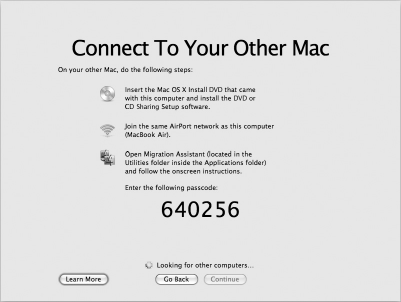
16 Chapter 1 Ready, Set Up, Go
3 When you see the Connect To Your Other Mac screen with a passcode displayed, do the
remaining steps on the other Mac. You will enter the passcode in Migration Assistant
on the other Mac.
>>>REVIEWERS: Waiting for updated screenshot with no DVD mention
4 On the other Mac, open Migration Assistant (located in /Applications/Utilities/), and
then click Continue.
5 When you are prompted for a migration method, select “To another Mac”, and then click
Continue.
6 On the other Mac, quit any other open applications and then click Continue.
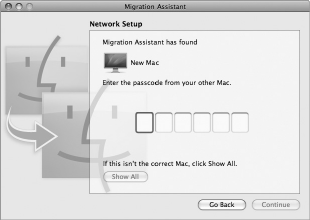
17Chapter 1 Ready, Set Up, Go
7 On the other Mac, enter the six-digit passcode displayed in Setup Assistant on your
new MacBook Air .
You can choose the items (user accounts, documents, movies, music, photos, and so on)
that you want to migrate to your MacBook Air.
8 Click Continue to start the migration.
Important: Don’t use the other Mac for anything else until the migration is complete.
If the connection is terminated during migration, you can resume the migration at
a later time using Migration Assistant on your MacBook Air and your other Mac.
18 Chapter 1 Ready, Set Up, Go
Getting Additional Information onto Your MacBook Air
Your MacBook Air comes with several applications installed, including the iLife suite.
Many other applications can be downloaded from the Internet. If you want to install
third-party applications from a DVD or CD, you can:
ÂInstall applications onto your MacBook Air or share information using the optical
disc drive on another Mac or Windows computer (if DVD or CD Sharing is set up and
enabled). Read the next section for more information.
ÂAttach the Apple USB SuperDrive (an external USB optical disc drive available
separately at www.apple.com/store) to the USB port on your MacBook Air, and
insert your installation disc.
Sharing Discs with DVD or CD Sharing
You can enable DVD or CD Sharing on a Mac or Windows computer to use the Remote
Disc feature of MacBook Air. Remote Disc allows you to share the discs you insert into
the optical disc drive of the other computer. Some discs, such as DVD movies and game
discs, may be copy-protected and therefore unusable through DVD or CD Sharing.
Make sure DVD or CD Sharing is already set up on any Mac or Windows computer you
wanttopartnerwith.Seepage14forinformation.
To enable DVD or CD Sharing, if your other computer is a Mac:
1 Make sure the other Mac and your MacBook Air are on the same wireless network.
Check the AirPort (Z) status icon in the menu bar to see what network you’re
connected to.
OntheotherMac,chooseApple()>SystemPreferencesandthenopenSharing.
19Chapter 1 Ready, Set Up, Go
2 In the Sharing panel, select “DVD or CD Sharing” in the Service list. If you want other
users to request permission to share a DVD or CD, select “Ask me before allowing others
to use my DVD drive.”
To enable DVD or CD Sharing, if your other computer is a Windows computer:
1 Make sure your MacBook Air and the Windows computer are on the same wireless
network.
2 On the Windows computer, open the DVD or CD Sharing control panel.
3 Select “Enable Remote DVD or CD.” If you want other users to request permission to
share a DVD or CD, select “Ask me before allowing others to use my DVD drive.”
To use a shared DVD or CD:
1 On the other computer, insert a DVD or CD into the optical disc drive.
2 On your MacBook Air, select the Remote Disc when it appears under Devices in the
Finder sidebar. If you see the “Ask to use” button, click it.
3 On the other computer, when prompted, click Accept to allow your MacBook Air to use
the DVD or CD.
4 On your MacBook Air use the disc as you normally would once it becomes available.
If you try to shut down the other computer or eject the shared DVD or CD while your
MacBook Air is using it, you’ll see a message telling you that the disc is in use. To
proceed, click Continue.
20 Chapter 1 Ready, Set Up, Go
Putting Your MacBook Air to Sleep or Shutting It Down
WhenyounishworkingwithyourMacBookAir,youcanputittosleeporshut
it down.
Putting Your MacBook Air to Sleep
If you’ll be away from your MacBook Air for only a short time, put it to sleep. When the
computer is in sleep, you can quickly wake it and bypass the startup process.
To put your MacBook Air to sleep, do one of the following:
ÂClose the display.
ÂChooseApple()>Sleepfromthemenubar.
ÂPress the power (®) button and click Sleep in the dialog that appears.
ÂChooseApple()>SystemPreferences,clickEnergy Saver, and set a sleep timer.
To wake your MacBook Air:
ÂIf the display is closed, simply open it to wake your MacBook Air.
ÂIf the display is already open, press the power (®) button or any key on the keyboard.
When your MacBook Air wakes from sleep, your applications, documents, and
computer settings are exactly as you left them.
21Chapter 1 Ready, Set Up, Go
Shutting Down Your MacBook Air
If you aren’t going to use your MacBook Air for a day or two, it’s best to shut it down.
To shut down your MacBook Air, do one of the following:
ÂChooseApple()>ShutDownfromthemenubar.
ÂPress the power (®) button and click Shut Down in the dialog that appears.
If you plan to store your MacBook Air for an extended period of time, see “Important
Handling Information” on page 55 for information about how to prevent your battery
from draining completely.
>>>SW REVIEWERS: Should we change this language “If you aren’t going to use your
MacBook Air for a day or two...” to a longer period of time, given the deep sleep
feature?

www.apple.com/macosx
Mac Help Mac OS X
www.apple.com/macosx
Life with Your MacBook Air
2
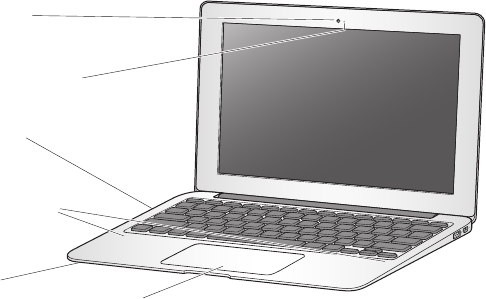
24 Chapter 2 Life with Your MacBook Air
Basic Features of Your MacBook Air
Microphone
Battery
(built-in)
Camera indicator light
iSight camera
Stereo speakers
(under keyboard)
Trackpad

25Chapter 2 Life with Your MacBook Air
Built-in iSight camera and camera indicator light
Videoconference with others using iChat, take pictures with Photo Booth, or capture
video with iMovie. The indicator light glows when the iSight camera is operating.
Built-in microphone
Capture sounds with the microphone (located on the left side, next to the headphone
jack) or talk with friends live over broadband using the included iChat application.
Built-in stereo speakers
Listentomusic,movies,games,andmultimediales.
Built-in rechargeable battery
Use battery power when you’re away from a power outlet.
Trackpad
Click or double-click anywhere on the trackpad. Touch the trackpad with one or more
ngerstomovethepointeranduseMulti-Touchgestures(describedonpage30).
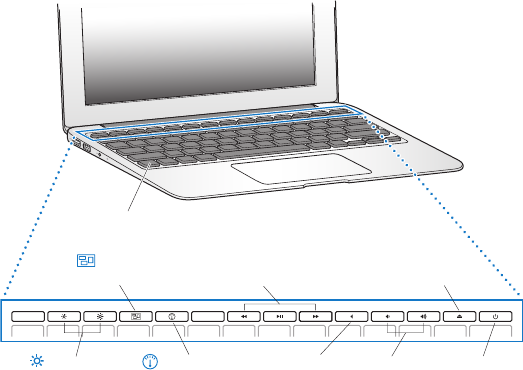
26 Chapter 2 Life with Your MacBook Air
Keyboard Features of Your MacBook Air
Function (fn) key
—
C
-Volume
keys
Brightness
keys
Media
Eject key
Mute
key
Exposé
key
Dashboard
key
Media
keys
’
Power
button
®
esc F1 F2 F3 F4 F5 F6 F7 F8 F9 F10 F11 F12

27Chapter 2 Life with Your MacBook Air
Function (fn) key
Press and hold this key to activate customized actions assigned to the function keys
(F1toF12).Tolearnhowtocustomizefunctionkeys,chooseHelp>MacHelpfromthe
menu bar and search for “function keys.”
¤Brightness keys (F1, F2)
Increase ( ) or decrease ( ) the brightness of the screen.
Exposé key (F3)
Open Exposé for quick access to all your open windows.
Dashboard key (F4)
Open Dashboard to access your widgets.
’Media keys (F7, F8, F9)
Rewind (]), play or pause (’), or fast-forward (‘) a song, movie, or slideshow.
—Mute key (F10)
Mute the sound coming from the built-in speakers and audio out port.
-Volume keys (F11, F12)
Increase (-) or decrease (–) the volume of sound coming from the built-in speakers or
audio out port.
CMedia Eject key
Press and hold this key to eject a disc from a MacBook Air Superdrive (available
separately). You can also eject a disc by dragging its icon from the desktop to the Trash.
®Power button
TurnyourMacBookAironoro,orputittosleep.
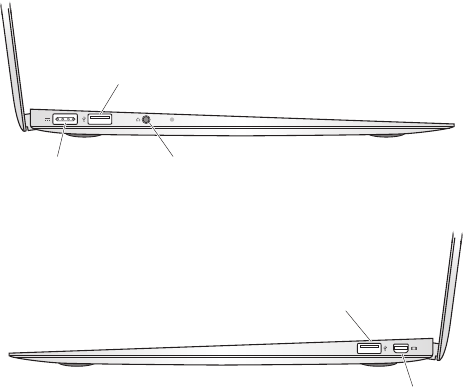
28 Chapter 2 Life with Your MacBook Air
Ports on Your MacBook Air
¯MagSafe
power port
Audio
out port
f
USB 2.0 port
d
Mini DisplayPort
£
USB 2.0 port
d

29Chapter 2 Life with Your MacBook Air
¯MagSafe power port
Plugintheincluded45WMagSafePowerAdaptertorechargetheMacBookAirbattery.
dUSB (Universal Serial Bus) 2.0 ports
Connect a MacBook Air SuperDrive, USB to Ethernet adapter, iPod, iPhone, iPad,
mouse, keyboard, printer, disk drive, digital camera, joystick, modem, and more to your
MacBook Air.
fAudio out port
Connect external speakers, headphones (including iPhone), or digital audio equipment.
£Mini DisplayPort (video out)
Connect to an external display or projection system that uses a DVI, Dual-Link DVI, or
VGA connector. You can purchase adapters for supported video formats.
Note: Adapters and other accessories are sold separately at www.apple.com/store or
your local Apple Retail Store.
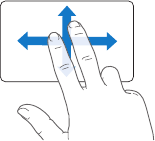
30 Chapter 2 Life with Your MacBook Air
Using the Multi-Touch Trackpad
Use the trackpad to move the pointer and to perform a variety of Multi-Touch gestures.
Unlike typical trackpads, the entire MacBook Air trackpad is a button, and you can click
anywhere on the trackpad. To enable Multi-Touch gestures, view instructional videos of
the gestures, and set other trackpad options, choose Apple()>SystemPreferences,
and then click Trackpad.
Here are way to use your MacBook Air trackpad:
ÂTwo-nger scrolling lets you drag to scroll quickly up, down, or sideways in the active
window. This option is on by default.
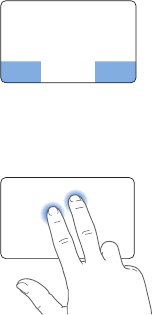
31Chapter 2 Life with Your MacBook Air
ÂSecondary clicking or “right-clicking” lets you access shortcut menu commands.
•Tosetupaone-ngersecondary-clickzoneinthebottomleftorrightcornerof
the trackpad, select Secondary Click under the One Finger option in Trackpad
preferences.
Secondary click zone
•Tosetuptwo-ngersecondaryclickinganywhereonthetrackpad,select
Secondary Click under the Two Fingers option in Trackpad preferences.
Note: You can also secondary click by holding down the Control key while you click.
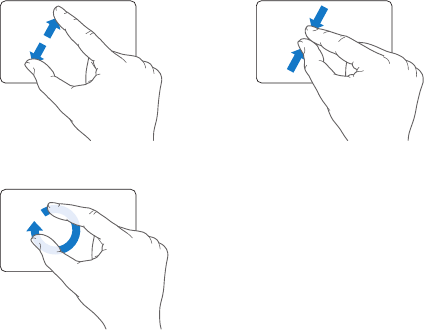
32 Chapter 2 Life with Your MacBook Air
The following trackpad gestures work in certain applications. When you perform these
gestures,slideyourngerslightlyonthesurfaceofthetrackpad.Formoreinformation,
seeTrackpadpreferencesorchooseHelp>MacHelpandsearchfor“trackpad.”
ÂTwo-nger pinching lets you zoom in or out on PDFs, images, photos, and more.
ÂTwo-nger rotating lets you rotate photos, pages, and more.
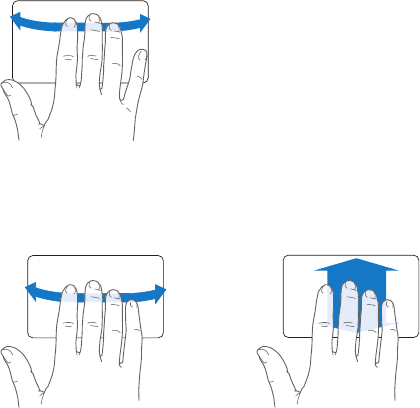
33Chapter 2 Life with Your MacBook Air
ÂThree-nger swiping lets you rapidly page through documents, move to the previous
or next photo, and more.
ÂFour-nger swiping works intheFinderandallapplications.Swipingfourngers
to the left or right activates Application Switcher so you can cycle through open
applications.SwipingfourngersupordowncausesExposétoshowthedesktopor
display all open windows.
To enable or disable any of the gestures, choose Apple()>SystemPreferences,and
thenclickTrackpad.Clickthecheckboxestoturnthegesturesonoro.

34 Chapter 2 Life with Your MacBook Air
Running Your MacBook Air on Battery Power
When the MagSafe Power Adapter isn’t connected, your MacBook Air draws power
from its built-in rechargeable battery. The length of time that you can run your
MacBook Air varies, depending on the applications you use and the external devices
connected to your MacBook Air.
TurningofeaturessuchasAirPortExtremeorBluetooth®wirelesstechnologyand
reducing screen brightness can help conserve battery charge —for example, when
you’re traveling by air. Many of your system preferences are automatically set to
optimize battery life.
Charging the Battery
You can determine whether the battery needs charging by looking at the indicator
light on the MagSafe connector. If the light is glowing amber, the battery needs to be
charged. If the light is glowing green, the battery is fully charged.
You can also check the amount of battery charge left by viewing the Battery ( )
status icon in the menu bar. The battery charge level displayed is based on the amount
of power left in the battery with the applications, peripheral devices, and system
settings you are currently using. To conserve battery power, close applications and
disconnect peripheral devices not in use, and adjust your Energy Saver settings. For
more information about battery conservation and performance tips, go to www.apple.
com/batteries/notebooks.html.
When the power adapter that came with your MacBook Air is connected, the battery
rechargeswhetherthecomputerison,o,orinsleep.Thebatteryrechargesmore
quickly,however,whenthecomputerisoorinsleep.

35Chapter 2 Life with Your MacBook Air
The battery in your MacBook Air can be replaced only by an Apple Authorized Service
Provider or at an Apple Retail Store.
Getting Answers
Much more information about using your MacBook Air is available in Mac Help and on
the Internet at www.apple.com/support/macbookair.
To get Mac Help:
1 Click the Finder icon in the Dock (the bar of icons along the edge of the screen).
2 Click the Help menu in the menu bar and do one of the following:
a TypeaquestionortermintheSearcheld,andselectatopicfromthereturnedlist
or select Show All Results to see all topics.
b Choose Mac Help to open the Mac Help window, where you can click links or type a
search question.

36 Chapter 2 Life with Your MacBook Air
More Information
For more information about using your MacBook Air, see the following:
To learn about See
Troubleshooting your
MacBook Air if you have
a problem
Chapter 3, “Problem, Meet Solution” on page 39.
Finding service and support
for your MacBook Air
“LearningMore,Service,andSupport”onpage47.Orgoto
the Apple Support website at www.apple.com/support/
macbookair.
Using Mac OS The Mac OS X website at www.apple.com/macosx.
Or search for “Mac OS X” in Mac Help.
Moving from a PC to a Mac “Why You’ll Love a Mac” at www.apple.com/getamac/whyamac.
Using iLife applications The iLife website at www.apple.com/ilife. Or open an iLife
application, open Help for the application, and then type a
questioninthesearcheld.
Changing System Preferences System Preferences by choosing Apple (K)>System
Preferences. Or search for “system preferences” in Mac Help.
Using the trackpad Open System Preferences, and then click Trackpad.
Using the keyboard Mac Help and search for “keyboard.”
Using the iSight camera Mac Help and search for “iSight.”
Using AirPort Extreme wireless
technology
The AirPort Support page at www.apple.com/support/airport.

37Chapter 2 Life with Your MacBook Air
To learn about See
Using Bluetooth wireless
technology
The Bluetooth Support page at www.apple.com/support/
bluetooth. Or open the Bluetooth File Exchange application,
located in the Utilities folder within the Applications folder, and
chooseHelp>BluetoothHelp.
Caring for the battery Mac Help and search for “battery.”
Connecting a printer Mac Help and search for “printing.”
USB connections Mac Help and search for “USB”.
Connecting to the Internet Mac Help and search for “Internet.”
Connecting an external display Mac Help and search for “display port.”
Specications The Specicationspageatsupport.apple.com/specs.Oropen
SystemProlerbychoosingApple(K)>AboutThisMacfrom
the menu bar, and then click More Info.
Apple news, free downloads,
and online catalogs of
software and hardware
The Apple website at www.apple.com.
Instructions, technical support,
and manuals for Apple
products
The Apple Support website at www.apple.com/support.

www.apple.com/macosx
Mac Help help
www.apple.com/support
Problem, Meet Solution
3
40 Chapter 3 Problem, Meet Solution
Occasionally you may have problems while working with your MacBook Air. Read
onfortroubleshootingtipstotrywhenyouhaveaproblem.Youcanalsondmore
troubleshooting information in Mac Help and on the MacBook Air Support website at
www.apple.com/support/macbookair.
If you experience a problem with your MacBook Air, there’s usually a simple and quick
solution. Think about the conditions that led up to the problem. Making a note of
things you did before the problem occurred will help you narrow down possible causes
andndtheanswersyouneed.Thingstonoteinclude:
ÂThe applications you were using when the problem occurred. Problems that occur
onlywithaspecicapplicationmightindicatethattheapplicationisnotcompatible
with the version of the Mac OS installed on your computer.
ÂAny new software that you installed, especially software that added items to the
System folder.
Problems That Prevent You from Using Your MacBook Air
If your MacBook Air doesn’t respond or the pointer doesn’t move
On rare occasions, an application might “freeze” on the screen. Mac OS X provides a way
to quit a frozen application without restarting your computer.
To force an application to quit:
1 Press Command (x)-Option-EscorchooseApple()>ForceQuitfromthemenubar.
TheForceQuitApplicationsdialogappearswiththeapplicationselected.
2 ClickForceQuit.
The application quits, leaving all other applications open.
41Chapter 3 Problem, Meet Solution
If you need to, you can also relaunch the Finder from this dialog.
Next, save your work in any open applications and restart the computer to make sure
the problem is entirely cleared up.
Iftheproblemoccursfrequently,chooseHelp>MacHelpfromthemenubaratthe
top of the screen. Search for the word “freeze” to get help for instances when the
computer freezes or doesn’t respond.
If the problem occurs only when you use a particular application, check with the
application’s manufacturer to see if it is compatible with your computer. To get support
and contact information for the software that came with your MacBook Air go to
www.apple.com/guide.
If you know an application is compatible, you might need to reinstall the application.
If your MacBook Air freezes during startup, or you see a ashingquestionmark, or
the display is dark
The ashingquestionmarkusuallymeansthatthecomputercan’tndthesystem
software on the hard disk or on any disks attached to the computer.
ÂWait a few seconds. If the computer still doesn’t start up, shut it down by holding
down the power (®) button for about 8 to 10 seconds. Disconnect all external
peripherals and try restarting by pressing the power (®) button while holding down
the Option key. When your computer starts up, click the hard disk icon, and then
click the right arrow. After the computer starts up, open System Preferences and click
Startup Disk. Select a local Mac OS X System folder.
42 Chapter 3 Problem, Meet Solution
If your MacBook Air doesn’t turn on or start up
Try the following suggestions in order until your computer turns on:
ÂMake sure the power adapter is plugged into the computer and into a functioning
poweroutlet.Besuretousethe45WMagSafePowerAdapterthatcamewithyour
MacBook Air. If the power adapter stops charging and you don’t see the indicator
light on the power adapter turn on when you plug in the power cord, try unplugging
and replugging the power cord to reseat it.
ÂCheck whether the battery needs to be recharged. If the light on the power adapter
glowsamber,thebatteryischarging.See“ChargingtheBattery”onpage34.
ÂIf the problem persists, reset the MacBook Air power manager (while still preserving
yourles)bypressingtheleftShiftkey,leftOption(alt)key,leftControlkey,andthe
power (®)buttonsimultaneouslyforvesecondsuntilthecomputerrestarts.
ÂPress and release the power (®) button and immediately hold down the Command
(x), Option, P, and R keys simultaneously until you hear the startup sound a second
time. This resets the parameter RAM (PRAM).
ÂIf you still can’t start up your MacBook Air, see “Learning More, Service, and Support”
onpage47forinformationaboutcontactingAppleforservice.

43Chapter 3 Problem, Meet Solution
If the screen suddenly goes black or your MacBook Air freezes
Try restarting your MacBook Air.
1 Unplug any devices that are connected to your MacBook Air, except the power adapter.
2 Press the power (®) button to restart the system.
3 Let the battery charge to at least 10 percent before plugging in any external devices
and resuming your work.
To see how much the battery has charged, look at the Battery ( ) status icon in the
menu bar.
The screen might also darken if you have energy saver features set for the battery.
If your MacBook Air can’t connect to another computer’s optical disc drive
To use services such as Migration Assistant, DVD or CD Sharing, and iTunes music
sharing, both your MacBook Air and the other computer must be connected to the
same network. If your MacBook Air is connected wirelessly and the other computer
is connected to a third-party router by Ethernet, check your router documentation to
make sure it supports bridging a wireless to wired connection.
If you need to reinstall Mac OS X and other software that came with your
MacBook Air, reset your password, or use Disk Utility
Contact AppleCare or your local Apple Retail Store. For more information, see “Learning
More,Service,andSupport”onpage47.
44 Chapter 3 Problem, Meet Solution
Using Apple Hardware Test
If you suspect a problem with the MacBook Air hardware, you can use the Apple
Hardware Test application to help determine if there’s a problem with one of the
computer’s components, such as the memory or processor.
To use Apple Hardware Test on your MacBook Air:
1 Disconnect all external devices from your computer except the power adapter.
2 Restart your MacBook Air while holding down the D key.
3 When the Apple Hardware Test chooser screen appears, select the language you want
to use.
4 Press the Return key or click the right arrow button.
5 WhentheAppleHardwareTestmainscreenappears(afterabout45seconds),follow
the onscreen instructions.
6 If Apple Hardware Test detects a problem, it displays an error code. Make a note of the
error code before pursuing support options. If Apple Hardware Test doesn’t detect a
hardware failure, the problem may be software related.
If this procedure doesn’t work, contact AppleCare or your local Apple Retail Store.
45Chapter 3 Problem, Meet Solution
Problems with Your Internet Connection
Your MacBook Air has a Network Setup Assistant application to help you set up an
Internet connection. Open System Preferences and click Network.
Click the “Assist me” button to open Network Setup Assistant.
If you have trouble with your Internet connection, try using Network Diagnostics.
To use Network Diagnostics:
1 ChooseApple()>SystemPreferences.
2 Click Network and then click “Assist me.”
3 Click Diagnostics to open Network Diagnostics.
4 Follow the onscreen instructions.
If Network Diagnostics can’t resolve the problem, there may be a problem with the
Internet service provider (ISP) you are trying to connect to, with an external device you
are using to connect to your ISP, or with the server you are trying to access.
If you have two or more computers sharing an Internet connection, be sure that your
wireless network is set up properly. You need to know if your ISP provides only one IP
address or if it provides multiple IP addresses, one for each computer.
If only one IP address is provided, then you must have a router capable of sharing
the connection, also known as network address translation (NAT) or “IP masquerading.”
46 Chapter 3 Problem, Meet Solution
For setup information, check the documentation provided with your router or
ask the person who set up your network. You can use an AirPort Base Station to
share one IP address among multiple computers. For information about using
an AirPort Base Station, check Mac Help or visit the Apple AirPort website at
www.apple.com/support/airport.
If you cannot resolve the issue using these steps, contact your ISP or network
administrator.
Problems with AirPort Extreme Wireless Communication
If you have trouble using AirPort Extreme wireless communication:
ÂMake sure the computer or network you are trying to connect to is running and has
a wireless access point.
ÂMakesureyouhaveproperlyconguredthesoftwareaccordingtotheinstructions
that came with your base station or access point.
ÂMake sure you are within range of the other computer or the network’s access
point. Nearby electronic devices or metal structures can interfere with wireless
communication and reduce this range. Repositioning or rotating the computer might
improve reception.
ÂCheck the AirPort (Z) status icon in the menu bar. Up to four bars appear, indicating
signal strength. If signal strength is low, try changing your location.
ÂSeeAirPortHelp(chooseHelp>MacHelp,andthenchooseLibrary>AirPortHelp
from the menu bar). Also see the instructions that came with the wireless device for
more information.
47Chapter 3 Problem, Meet Solution
Keeping Your Software Up to Date
You can connect to the Internet and automatically download and install the latest
free software versions, drivers, and other enhancements from Apple.
When you are connected to the Internet, Software Update checks to see if any updates
are available for your computer. You can set your MacBook Air to check for updates
periodically, and download and install updated software.
To check for updated software:
1 Choose Apple()>System Preferences.
2 Click the Software Update icon and follow the onscreen instructions.
ÂFor more information, search for “Software Update” in Mac Help.
ÂFor the latest information about Mac OS X, go to www.apple.com/macosx.
Learning More, Service, and Support
Your MacBook Air does not have any user-serviceable or user-replaceable parts. If
you need service, contact Apple or take your MacBook Air to an Apple Authorized
ServiceProvider.YoucanndmoreinformationabouttheMacBookAirthroughonline
resources, onscreen help, SystemProler,orAppleHardwareTest.
Online Resources
For online service and support information, go to www.apple.com/support. Choose
your country from the pop-up menu. You can search the AppleCare Knowledge Base,
check for software updates, or get help from Apple’s discussion forums.
48 Chapter 3 Problem, Meet Solution
Onscreen Help
Youcanoftenndanswerstoyourquestions,aswellasinstructionsand
troubleshooting information, in Mac Help.ChooseHelp>MacHelp.
SystemProler
TogetinformationaboutyourMacBookAir,useSystemProler.Itshowsyouwhat
hardware and software is installed, the serial number and operating system
version,howmuchmemoryisinstalled,andmore.ToopenSystemProler,choose
Apple()>AboutThisMacfromthemenubarandthenclickMoreInfo.
AppleCare Service and Support
Your MacBook Air comes with 90 days of technical support and one year of
hardware repair warranty coverage at an Apple Retail Store or an Apple-authorized
repair center, such as an Apple Authorized Service Provider. You can extend your
coverage by purchasing the AppleCare Protection Plan. For information, visit
www.apple.com/support/products or visit the website address for your country
listed later in the section.
If you need assistance, AppleCare telephone support representatives can help you
with installing and opening applications, and basic troubleshooting. Call the support
centernumbernearestyou(therst90daysarecomplimentary).Havethepurchase
date and your MacBook Air serial number ready when you call.

49Chapter 3 Problem, Meet Solution
Your 90 days of complimentary telephone support begins on the date of purchase.
Country Phone Website
United States 1-800-275-2273 www.apple.com/support
Australia (61)1-300-321-456 www.apple.com/au/support
Canada (English)
(French)
1-800-263-3394 www.apple.com/ca/support
www.apple.com/ca/fr/support
Ireland (353)1850946191 www.apple.com/ie/support
New Zealand 00800-7666-7666 www.apple.com/nz/support
United Kingdom (44)08442090611 www.apple.com/uk/support
Telephone numbers are subject to change, and local and national telephone rates may
apply. A complete list is available on the web:
www.apple.com/support/contact/phone_contacts.html
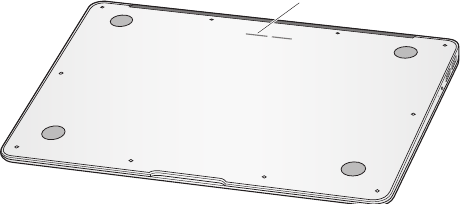
50 Chapter 3 Problem, Meet Solution
Locating Your Product Serial Number
Useoneofthesemethodstondyourcomputer’sserialnumber:
ÂTurn over your MacBook Air. The serial number is etched into the case near the hinge.
Serial number
ÂChooseApple()>AboutThisMac.Clicktheversionnumberbeneaththewords
“Mac OS X” to cycle through the Mac OS X version number, the build version, and the
serial number.
ÂClicktheFindericonandopen/Applications/Utilities/SystemProler.ClickHardware
in the Contents pane.

www.apple.com/macosx
Last, but Not Least
4
Mac Help ergonomics
www.apple.com/environment

52 Chapter 4 Last, but Not Least
For your safety and that of your equipment, follow these rules for handling and
cleaning your MacBook Air and for working more comfortably. Keep these instructions
handy for reference by you and others.
WARNING: Incorrect storage or use of your computer may void the manufacturer’s
warranty.
Important Safety Information
WARNING: Failuretofollowthesesafetyinstructionscouldresultinre,electricshock,
or other injury or damage.
Built-in battery Do not remove the battery from your MacBook Air. The battery should
be replaced only by an Apple Authorized Service Provider. Discontinue use of your
MacBook Air if it’s dropped or appears crushed, bent, deformed, or damaged. Do not
expose the computer to temperatures above 212° F or 100° C.
Proper handling Set up your MacBook Air on a stable work surface that allows
for adequate air circulation under and around the computer. Do not operate your
MacBookAironapilloworothersoftmaterial,asthematerialcanblocktheairow
vents. Never place anything over the keyboard when operating your computer. Never
push objects into the ventilation openings.
The bottom of your MacBook Air may become very warm during normal use. If your
MacBook Air is on your lap and gets uncomfortably warm, remove it from your lap and
place it on a stable work surface.
53Chapter 4 Last, but Not Least
Water and wet locations Keep your MacBook Air away from sources of liquid, such
as drinks, washbasins, bathtubs, shower stalls, and so on. Protect your computer from
dampness or wet weather, such as rain, snow, and fog.
45W MagSafe Power Adapter Make sure the AC plug or AC power cord is fully
inserted into the power adapter before plugging the adapter into a power outlet. Use
only the power adapter that came with your MacBook Air, or an Apple-authorized
power adapter that is compatible with this product. The AC power cord provides a
grounded connection. The power adapter may become very warm during normal use.
Alwaysputthepoweradapterdirectlyintoapoweroutlet,orplaceitontheoorin
a well-ventilated location.
Disconnect the power adapter and disconnect any other cables if any of the following
conditions exists:
ÂYou want to clean the case (use only the recommended procedure described in
“Important Handling Information” on page 55).
ÂThe power cord or plug becomes frayed or otherwise damaged.
ÂYour MacBook Air or power adapter is exposed to rain, excessive moisture, or liquid
spilled into the case.
ÂYour MacBook Air or power adapter has been dropped, the case has been damaged,
or you suspect that service or repair is required.
The MagSafe power port contains a magnet that can erase data on a credit card, iPod,
or other device. To preserve your data, do not place these and other magnetically
sensitive material or devices within 1 inch (25 mm) of this port.
If debris gets into the MagSafe power port, remove it gently with a dry cotton swab.
54 Chapter 4 Last, but Not Least
MagSafepowerspecications: (>>> REVIEWERS: Please update for 45W)
ÂFrequency: 50 to 60 Hz, single phase
ÂLine Voltage:100to240V
ÂOutput Voltage: 16.5 V DC, 3.65 A
Hearing damage Permanent hearing loss may occur if earbuds or headphones are
used at high volume. You can adapt over time to a higher volume of sound that may
sound normal but can be damaging to your hearing. If you experience ringing in your
earsormuedspeech,stoplisteningandhaveyourhearingchecked.Thelouderthe
volume,thelesstimeisrequiredbeforeyourhearingcouldbeaected.Hearingexperts
suggest that to protect your hearing:
ÂLimit the amount of time you use earbuds or headphones at high volume.
ÂAvoid turning up the volume to block out noisy surroundings.
ÂTurn the volume down if you can’t hear people speaking near you.
High-risk activities This computer is not intended for use in the operation of nuclear
facilities,aircraftnavigationorcommunicationssystems,airtraccontrolsystems,or
for any other uses where a failure of the computer system could lead to death, personal
injury, or severe environmental damage.

55Chapter 4 Last, but Not Least
Important Handling Information
NOTICE: Failure to follow these handling instructions could result in damage to your
MacBook Air or other property.
Operating environmentOperatingyourMacBookAiroutsidetheserangesmayaect
performance:
ÂOperating temperature: 50° to 95° F (10° to 35° C)
ÂStorage temperature:-4°to113°F(-20°to45°C)
ÂRelative humidity: 5% to 90% (noncondensing)
ÂOperating altitude:0to10,000feet(0to3048meters)
Turning on your MacBook Air Never turn on your MacBook Air unless all of its internal
and external parts are in place. Operating your computer when parts are missing may
be dangerous and may damage the computer.
Carrying your MacBook Air If you carry your MacBook Air in a bag or briefcase, make
sure that there are no loose items (such as paper clips or coins) that could accidentally
get inside the computer through vent openings or get stuck inside a port. Also, keep
magnetically sensitive items away from the MagSafe power port.
Using connectors and ports Never force a connector into a port. When connecting
a device, make sure the port is free of debris, that the connector matches the port, and
that you have positioned the connector correctly in relation to the port.
Handling glass parts Your MacBook Air contains glass components, including the
display and trackpad. If they are damaged, don’t use your MacBook Air until it has been
repaired by an Apple Authorized Service Provider.
56 Chapter 4 Last, but Not Least
Storing your MacBook Air If you are going to store your MacBook Air for an extended
periodoftime,keepitinacoollocation(ideally,71°For22°C)anddischargethe
batteryto50percent.Whenstoringyourcomputerforlongerthanvemonths,
discharge the battery to approximately 50 percent. To maintain the capacity of the
battery, recharge the battery to 50 percent every six months or so.
Cleaning your MacBook Air When cleaning the outside of your computer and its
components,rstshutdownyourMacBookAir,andthenunplugthepoweradapter.
Then use a damp, soft, lint-free cloth to clean the computer’s exterior. Avoid getting
moisture in any openings. Do not spray liquid directly on the computer. Do not use
aerosolsprays,solvents,orabrasivesthatmightdamagethenish.
Cleaning the MacBook Air screenTocleanyourMacBookAirscreen,rstshutdown
your MacBook Air and unplug the power adapter. Then use a damp, soft, lint-free cloth
to clean the computer’s exterior. Avoid getting moisture in any openings. Do not spray
liquid directly on the computer. Do not use aerosol sprays, solvents, or abrasives that
mightdamagethenish.
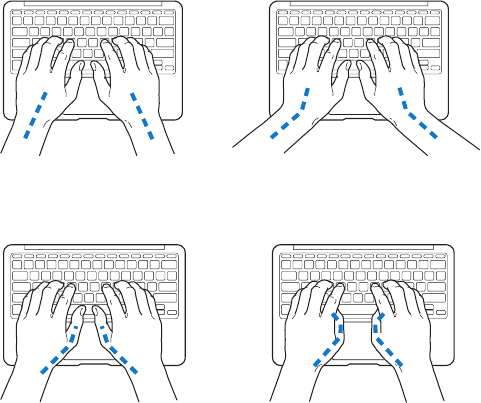
57Chapter 4 Last, but Not Least
Understanding Ergonomics
Here are some tips for setting up a healthy work environment.
Keyboard and Trackpad
When you use the keyboard and trackpad, your shoulders should be relaxed. Your
upper arm and forearm should form an angle that is slightly greater than a right angle,
with your wrist and hand in roughly a straight line.
Not this
This
Usealighttouchwhentypingorusingthetrackpadandkeepyourhandsandngers
relaxed. Avoid rolling your thumbs under your palms.
Not this
This
58 Chapter 4 Last, but Not Least
Change hand positions often to avoid fatigue. Some computer users might develop
discomfort in their hands, wrists, or arms after intensive work without breaks. If you
begin to develop chronic pain or discomfort in your hands, wrists, or arms, consult a
qualiedhealthspecialist.
External Mouse
If you use an external mouse, position the mouse at the same height as the keyboard
and within a comfortable reach.
Chair
Anadjustablechairthatprovidesrm,comfortablesupportisbest.Adjusttheheight
ofthechairsoyourthighsarehorizontalandyourfeetareatontheoor.Thebackof
the chair should support your lower back (lumbar region). Follow the manufacturer’s
instructionsforadjustingthebackresttotyourbodyproperly.
You might have to raise your chair so that your forearms and hands are at the proper
angletothekeyboard.Ifthismakesitimpossibletorestyourfeetatontheoor,you
can use a footrest with adjustable height and tilt to make up for any gap between the
oorandyourfeet.Oryoucanlowerthedesktoptoeliminatetheneedforafootrest.
Another option is to use a desk with a keyboard tray that’s lower than the regular work
surface.
Built-In Display
Adjusttheangleofthedisplaytominimizeglareandreectionsfromoverhead
lights and windows. Do not force the display if you meet resistance. The display is
not designed to open past 135 degrees.
You can adjust the brightness of the screen when you take the computer from one
work location to another, or if the lighting in your work area changes.

59Chapter 4 Last, but Not Least
More information about ergonomics is available on the web:
www.apple.com/about/ergonomics
Apple and the Environment
Apple Inc. recognizes its responsibility to minimize the environmental impacts of its
operations and products.
More information is available on the web:
www.apple.com/environment
60
Regulatory Compliance InformationRegulatory Compliance Information
FCC Compliance Statement
This device complies with part 15 of the FCC rules. Operation
is subject to the following two conditions: (1) This device may
not cause harmful interference, and (2) this device must accept
any interference received, including interference that may cause
undesired operation. See instructions if interference to radio or
television reception is suspected.
L‘utilisation de ce dispositif est autorisée seulement aux conditions
suivantes: (1) il ne doit pas produire de brouillage et (2)
l’utilisateur du dispositif doit étre prêt à accepter tout brouillage
radioélectrique reçu, même si ce brouillage est susceptible de
compromettre le fonctionnement du dispositif.
Radio and Television Interference
This computer equipment generates, uses, and can radiate radio-
frequency energy. If it is not installed and used properly—that
is, in strict accordance with Apple’s instructions—it may cause
interference with radio and television reception.
This equipment has been tested and found to comply with
the limits for a Class B digital device in accordance with the
specicationsinPart15ofFCCrules.Thesespecications
are designed to provide reasonable protection against such
interference in a residential installation. However, there is
no guarantee that interference will not occur in a particular
installation.
You can determine whether your computer system is causing
interferencebyturningito.Iftheinterferencestops,itwas
probably caused by the computer or one of the peripheral devices.
If your computer system does cause interference to radio or
television reception, try to correct the interference by using one or
more of the following measures:
• Turn the television or radio antenna until the interference stops.
• Move the computer to one side or the other of the television
or radio.
• Move the computer farther away from the television or radio.
• Plugthecomputerintoanoutletthatisonadierentcircuit
from the television or radio. (That is, make certain the computer
andthetelevisionorradioareoncircuitscontrolledbydierent
circuit breakers or fuses.)
If necessary, consult an Apple Authorized Service Provider or
Apple. See the service and support information that came with
your Apple product. Or consult an experienced radio/television
technician for additional suggestions.
Important: Changesormodicationstothisproductnot
authorized by Apple Inc. could void the EMC compliance and
negate your authority to operate the product.
This product has demonstrated EMC compliance under conditions
that included the use of compliant peripheral devices and shielded
cables (including Ethernet network cables) between system
components. It is important that you use compliant peripheral
devices and shielded cables between system components to
reduce the possibility of causing interference to radios, television
sets, and other electronic devices.
Responsible party (contact for FCC matters only):
Apple Inc. Corporate Compliance
1InniteLoop,MS26-A
Cupertino,CA95014
Wireless Radio Use
This device is restricted to indoor use when operating in the 5.15 to
5.25 GHz frequency band.
Cet appareil doit être utilisé à l’intérieur.
Exposure to Radio Frequency Energy
The radiated output power of the AirPort Extreme technology is
below the FCC radio frequency exposure limits. Nevertheless, it is
advised to use the wireless equipment in such a manner that the
potential for human contact during normal operation is minimized.
FCC Bluetooth Wireless Compliance
The antenna used with this transmitter must not be colocated or
operated in conjunction with any other antenna or transmitter
subject to the conditions of the FCC Grant.
Bluetooth Industry Canada Statement
This Class B device meets all requirements of the Canadian
interference-causing equipment regulations.
Cet appareil numérique de la Class B respecte toutes les exigences
du Règlement sur le matériel brouilleur du Canada.
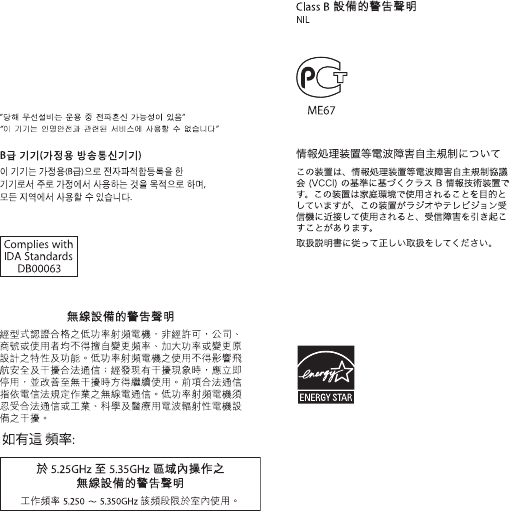
61
Industry Canada Statement
ComplieswiththeCanadianICES-003ClassBspecications.
Cet appareil numérique de la classe B est conforme à la norme
NMB-003 du Canada. This device complies with RSS 210 of Industry
Canada.
Europe—EU Declaration of Conformity
See: www.apple.com/euro/compliance
Korea Warning Statements
SingaporeWirelessCertication
Taiwan Wireless Statements
Taiwan Class B Statement
Russia
VCCI Class B Statement
External USB Modem Information
When connecting your MacBook Air to the phone line using an
external USB modem, refer to the telecommunications agency
information in the documentation that came with your modem.
ENERGY STAR® Compliance
As an ENERGY STAR® partner, Apple has determined that standard
congurationsofthisproductmeettheENERGYSTAR® guidelines
forenergyeciency.TheENERGYSTAR® program is a partnership
with electronic equipment manufacturers to promote energy-
ecientproducts.Reducingenergyconsumptionofproducts
saves money and helps conserve valuable resources.
This computer is shipped with power management enabled with
the computer set to sleep after 10 minutes of user inactivity. To
wake your computer, click the mouse or trackpad button or press
any key on the keyboard.
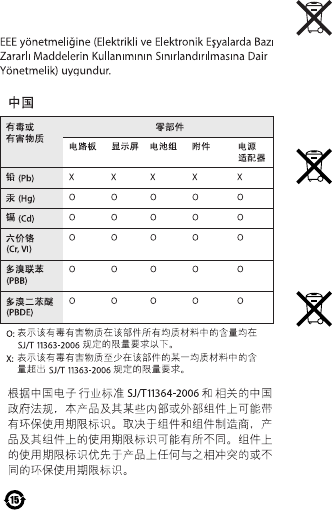
62
For more information about ENERGY STAR®, visit:
www.energystar.gov
Türkiye
020-5563-A
EFUP15china
Disposal and Recycling Information
This symbol indicates that your product must be disposed of
properly according to local laws and regulations. When your
product reaches its end of life, contact Apple or your local
authorities to learn about recycling options.
For information about Apple’s recycling program, go to:
www.apple.com/recycling.
Brasil: Informações sobre descarte e reciclagem
O símbolo indica que este produto e/ou sua bateria não devem
serdescartadasnolixodoméstico.Quandodecidirdescartareste
produto e/ou sua bateria, faça-o de acordo com as leis e diretrizes
ambientais locais. Para informações sobre o programa de
reciclagem da Apple, pontos de coleta e telefone de informações,
visite www.apple.com/br/environment.
European Union—Disposal Information
The symbol above means that according to local laws and
regulations your product should be disposed of separately from
household waste. When this product reaches its end of life, take
it to a collection point designated by local authorities. Some
collection points accept products for free. The separate collection
and recycling of your product at the time of disposal will help
conserve natural resources and ensure that it is recycled in a
manner that protects human health and the environment.
Battery Disposal Information
Dispose of batteries according to your local environmental laws
and guidelines.
Deutschland: Dieses Gerät enthält Batterien. Bitte nicht in den
Hausmüll werfen. Entsorgen Sie dieses Gerätes am Ende seines
Lebenszyklus entsprechend der maßgeblichen gesetzlichen
Regelungen.

63
Nederlands: Gebruikte batterijen kunnen worden ingeleverd bij de
chemokar of in een speciale batterijcontainer voor klein chemisch
afval (kca) worden gedeponeerd.
Taiwan:

Looking for Something?
66 Looking for Something?
A
AC plug 10
AC power adapter. See power
adapter
AC power cord 10
AirPort Extreme
troubleshooting 45
AppleCare 47
AppleHardwareTest,using 43
application freeze 39
applications
iChat 25
iLife 36
Application Switcher 33
B
battery
charging 34
disposal 67
location 25
performance 34
storing 61
blinkingquestionmark 40
brightnesskeys 27
built-in speaker 25
button,power 11,27
C
camera. See iSight video
camera
carrying your computer 60
changing
System Preferences 13
the desktop 13
chargingthebattery 34
cleaning
the display 61
your computer 61
computer
disposingof 67
freezes 40
putting to sleep 20
shutting down 21
specications 37
turning on 11
waking 20
won’tturnon 41
connection problems with
anothercomputer 42
Control-click 31
cord, AC power 10
D
Dashboardkey 27
desktop, customizing 13
display
cleaning 61
external 29
goesblack 42
Dock 35
downloadingsoftware 46
DVD or CD Sharing
installing software 15
overview 18
with Windows computer 19
E
Energy Saver preferences 20
environmentalimpact 64
ergonomics 62
Exposékey 27
external display port 29
F
F1toF12functionkeys 27
Fast-forwardkey 27
ashingquestionmark 40
ForceQuit 39
four-ngerswiping 33
frozen application 39
Function(fn)key 27
67Looking for Something?
H
hand positions,
recommended 62
headphone jack 29
help,ndinganswers 35
I
iChat application 25
iLife applications 36
installing DVD or CD Sharing
Setup 15
IPmasquerading 44
iSight video camera 25
K
keyboard. See also keys
ergonomics 62
features 26
shortcuts 31
keys
brightness 27
Dashboard 27
Exposé 27
Function(fn) 27
media 27
MediaEject 27
Mute 27
volumecontrol 27
M
Mac Help 35
Mac OS X website 36
MagSafe power adapter.
See power adapter
MagSafe power port 29
MediaEjectkey 27
mediakeys 27
microphone 25
migrating information 15
Migration Assistant 16
Mini DisplayPort 29
mouse 29, 63. See
also trackpad
Mutekey 27
N
network address translation
(NAT) 44
NetworkDiagnostics 44
NetworkSetupAssistant 44
O
onlineresources 46
optical disc sharing. See DVD or
CD sharing
P
paging through documents
using trackpad 33
partner computer
connectionproblems 42
DVD or CD Sharing Setup
software 14
pinching to zoom 32
Play/Pausekey 27
plug, AC 10
ports
headphone 29
MagSafe power 29
Mini DisplayPort 29
USB 2.0 29
power adapter
port 29
safety information 58
setup 10
powerbutton 11,27
problems. See troubleshooting
putting your computer to
sleep 20
Q
questionmark,ashing 40
quitting an application 39
R
rechargeablebattery 34
Remote Disc 18, 19
Rewindkey 27
right-clicking 31
rotating objects using
trackpad 32
S
safety
generalinstructions 57
handling information 60
68 Looking for Something?
important information 8
power adapter 58
screen. See display
scrollingwithtwongers 30
secondary clicking 31
serialnumber,locating 49
serviceandsupport 46
Setup Assistant 12
shared optical disc 18
sharingles 19
shutting down 21
sleep mode
20
software
installing DVD or CD
sharing 15
updating 46
Software Update
preferences 46
speaker 25
specications 37
stopping
an application 39
the computer 21
storing your computer 61
support contact
information 46
swiping
to move through
documents 33
to switch applications 33
System Preferences
customizing the desktop 13
Energy Saver 20
SystemProler 46
T
three-ngerswiping 33
trackpad
paging 33
pinching 32
rotating 32
scrolling 30
swiping 33
switching applications 33
zooming 32
troubleshooting
AirPort 45
AppleCare 47
computerfreezes 40
computerwon’tturnon 41
connecting to partner
computer 42
displaygoesblack 42
hardwareproblems 43
pointer won’t move 39
serviceandsupport 46
usingAirPort 45
usingMacHelp 35,47
turning on your computer 11
two-ngerpinching 32
two-ngerrotating 32
typing position 62
U
updatingsoftware 46
USB
connections 37
ports 29
V
video
camera indicator light 25
Mini DisplayPort 29
volumecontrolkeys 27
W
waking your computer 20
Z
zooming using the
trackpad 32
K Apple Inc.
© 2010 Apple Inc. All rights reserved.
Under the copyright laws, this manual may not be copied, in whole
or in part, without the written consent of Apple.
Everyeorthasbeenmadetoensurethattheinformationin
this manual is accurate. Apple is not responsible for printing or
clerical errors.
Apple
1InniteLoop
Cupertino,CA95014
408-996-1010
www.apple.com
Apple, the Apple logo, AirPort, AirPort Extreme, Cover Flow, Exposé,
GarageBand, iCal, iChat, iLife, iMovie, iPhoto, iPod, iSight, iTunes,
Keynote, Mac, MacBook, MacBook Air, Macintosh, Mac OS, MagSafe,
Photo Booth, Spotlight, SuperDrive, and Time Machine are
trademarks of Apple Inc., registered in the U.S. and other countries.
Finder and Multi-Touch are trademarks of Apple Inc.
AppleCare, Apple Store, and iTunes Store are service marks of
Apple Inc., registered in the U.S. and other countries.
ENERGYSTAR®isaU.S.registeredtrademark.
Intel, Intel Core, and Xeon are trademarks of Intel Corp. in the U.S.
and other countries.
TheBluetooth®wordmarkandlogosareownedbytheBluetooth
SIG, Inc. and any use of such marks by Apple Inc. is under license.
Other company and product names mentioned herein are
trademarks of their respective companies. Mention of third-party
products is for informational purposes only and constitutes
neither an endorsement nor a recommendation. Apple assumes
no responsibility with regard to the performance or use of these
products.
Manufactured under license from Dolby Laboratories. “Dolby,”
“Pro Logic,” and the double-D symbol are trademarks of Dolby
Laboratories.CondentialUnpublishedWorks,©1992–1997Dolby
Laboratories, Inc. All rights reserved.
Simultaneously published in the United States and Canada.